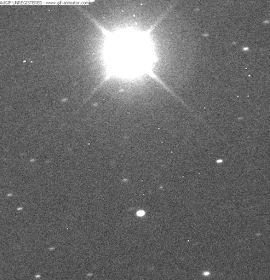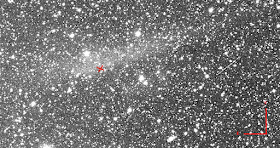The *big* problem imaging the
"debris" of
C/2010 X1 (Elenin),
is the low S/N of the little cloud it left away. If you want to
integrate enough, in order to increase the S/N of yours images, then you
face the problem of the trailed stars that are crossing the field,
producing an annoying interference with the faint cometary cloud.
A professional astronomer (
CARA's collaborator
Gian Paolo Tozzi,
Arcetri Observatory, Italy), suggested to shoot again the field of the
comet with the same instrumentation when the comet moved away, and then
to subtract the field stars from the cometary original images you want
to enhance. In principle, this would help to eliminate at least some
part of the disturbing effect produced by the trailed stars.
We tried this interesting technique on the images we obtained on 2011 Oct. 23.37 (see our
previous post), and we obtained the following result (click on the thumbnail for a bigger version):
We have still to improve this method (we found some issues matching the size of the field stars, due to the different seeing conditions and/or focus on two consecutive nights), anyway the results looks pretty promising. The image treated in this way, is significantly cleaner, and some features of C/2010 X1 (Elenin) are easier to be seen. In particular, the sunward part of the "cometary cloud" appears much sharper compared to the antisolar direction. The diffuse shape of the comet appears to be somehow "conical", about 1.5 deg long overall, with a maximum thickness of about 10-arcmin in the solar direction: the ovate shape of the "cometary cloud" than thinners tailward. We failed to find any convincing condensation within it, provided that the few "knots" visible on our image, are probably due to some noise left by the star profile removal process.
Talking about morphology, it's interesting to notice some similarities of what we found in our image, with this archive image of comet Shoemaker-Levy 9, seen after its break-up (Lowell Observatory 1.1m Hall telescope of 23 June 1993):

UPDATE OCTOBER 25, 2011
Below you can see a new elaboration of the previous image (click on the thumbnail for a bigger version):
by Giovanni Sostero, Ernesto Guido and Nick Howes






















